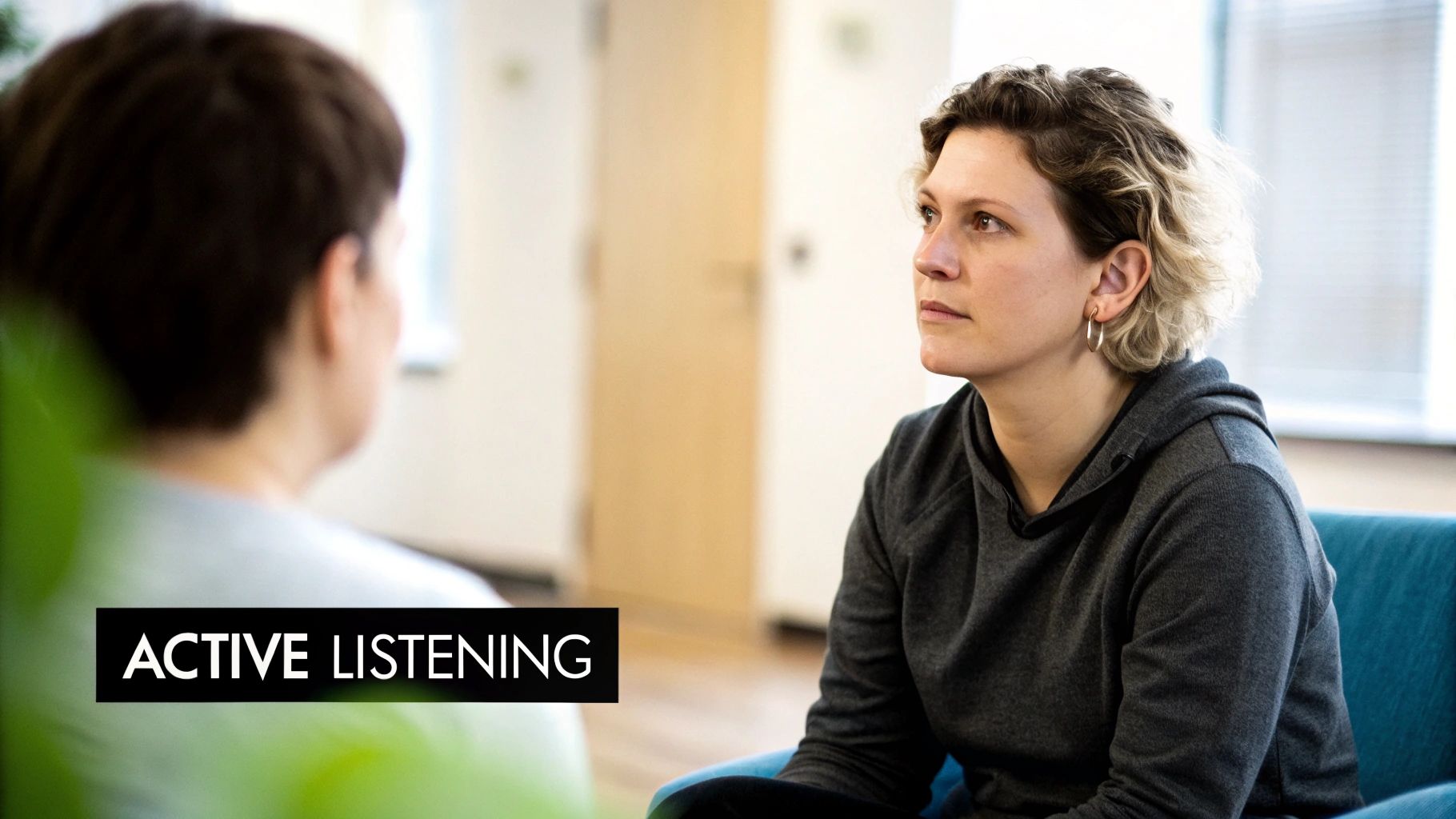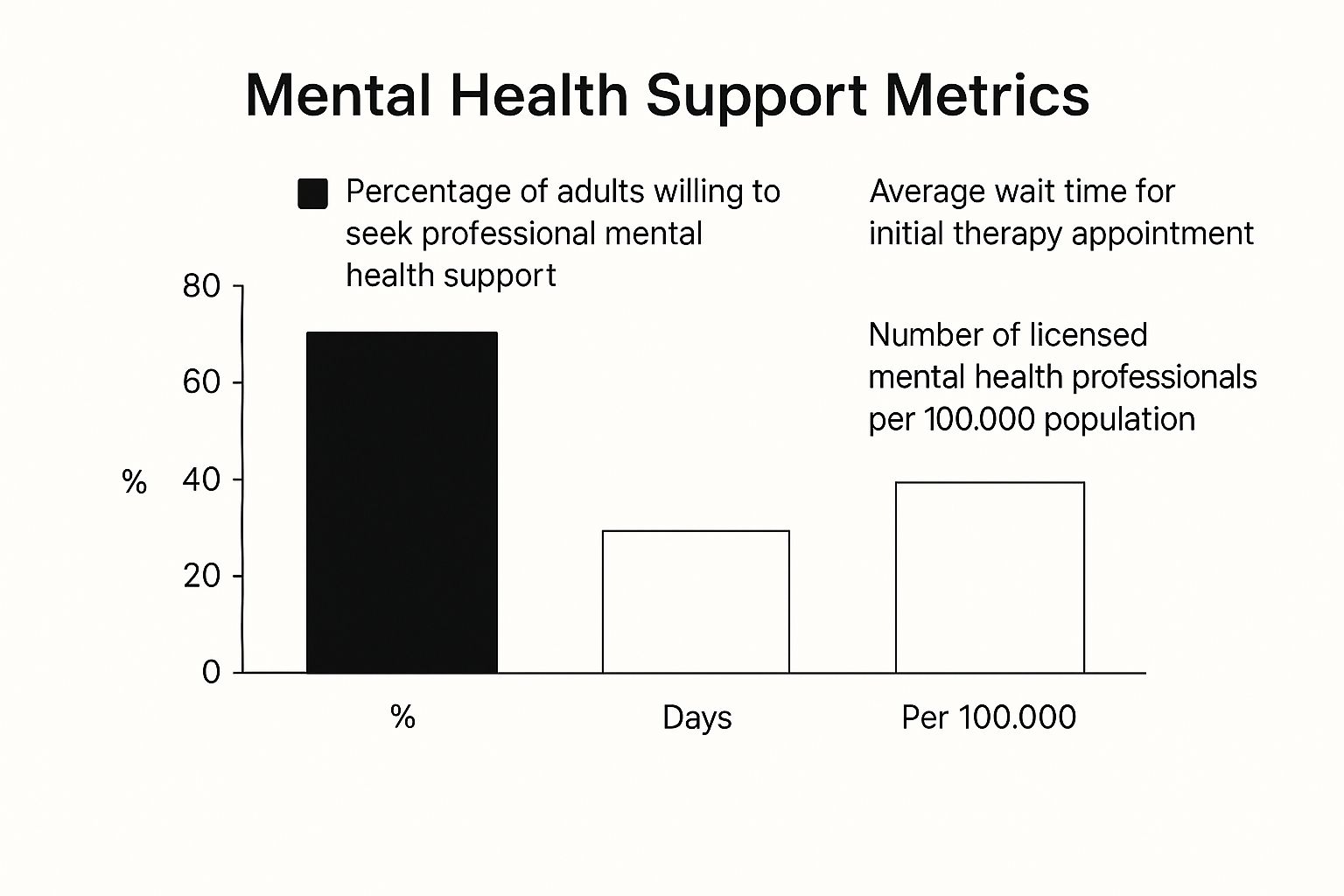
How to Talk About Mental Health with Confidence
Share
Starting a conversation about mental health is really about one thing: choosing to be present. It’s about creating a safe, non-judgemental space where someone feels comfortable enough to share what’s really going on. It’s about listening far more than you speak and validating their experience, not trying to "fix" it.
Sometimes, all it takes is a simple, quiet question: "How have you been feeling lately?" That single sentence can be the first step on a vital journey.
Why These Conversations Matter More Than Ever
Let's be honest, bringing up mental health can feel incredibly daunting. You worry about saying the wrong thing, making someone uncomfortable, or opening a door you don’t feel equipped to walk through. But pushing past that discomfort is one of the most powerful things you can do for a friend, a family member, or a colleague.
These simple, open chats are often the very first step in someone’s journey toward getting help. They dismantle the stigma that thrives in silence and can be a lifeline for someone who feels completely isolated. Addressing mental health openly isn't just an act of kindness; it's a crucial component of a healthy, functioning society. When we talk, we normalise seeking help and build stronger, more resilient communities.
The Scale of the Challenge in the UK
To really get why these conversations are so critical, you have to understand the sheer scale of mental health challenges across the country. In England, roughly 1 in 4 adults experiences a mental health problem each year. It’s incredibly common.
Drilling down into the numbers, it's clear that women are disproportionately affected, with 20.7% experiencing common mental health disorders compared to 13.2% of men. The situation is particularly acute for young women aged 16 to 24, where that number rises to a staggering 28.2%. For a deeper dive into the latest figures, Priory Group offers a detailed analysis of mental health statistics and trends.
And this isn’t just an adult issue. The mental wellbeing of our children and young people is a growing concern. In fact, NHS data from 2023 showed that 1 in 5 children and young people aged 8 to 25 in England had a probable mental disorder. The pressures from school, the constant hum of social media, and the maze of navigating friendships can take a significant toll. Early, open conversations at home and in school are crucial for building the emotional resilience they'll need for life.
The Ripple Effect of Silence
When mental health is left unspoken, the consequences ripple outwards. It doesn't just affect individuals; it impacts entire communities and even the economy. Take the workplace, for example. Poor mental health is a leading cause of absenteeism and lost productivity.
The cost to UK businesses is significant. A 2022 report by Deloitte found that the total annual cost of poor mental health to employers has risen to £56 billion, a 25% increase since 2019. That alone is a clear sign that fostering a supportive culture is a commercial necessity, not just a compassionate one.
A Crucial Disclaimer: I need to be really clear here: I am not a mental health professional. This guide is built on shared experience and research, with the sole aim of empowering you to start supportive conversations. If you or someone you know is in distress or you are genuinely worried about their wellbeing, it is essential to consult a doctor or a qualified mental health professional for proper guidance.
Tools for Normalising the Conversation
Thankfully, the dialogue around mental health is slowly changing, partly thanks to a growing ecosystem of supportive resources. Simple, everyday tools can help normalise these discussions and make them feel less intimidating.
- Mental Health Apparel: Something as simple as wearing a t-shirt or a hoodie with a positive affirmation can act as a subtle but powerful conversation starter. It signals that you are a safe person to talk to.
- Mental Health Books: Reading and sharing books that explore emotional wellbeing, especially with children, provides a shared language and a framework for understanding complex feelings. Some great examples include "The Boy, the Mole, the Fox and the Horse" by Charlie Mackesy or "Reasons to Stay Alive" by Matt Haig.
- Relaxation Techniques: Sometimes, an action is better than words. Suggesting a shared, calming activity like a walk in nature, trying some deep breathing exercises together (like the 4-7-8 technique), or simply putting on a calming playlist can create a relaxed environment where conversation can flow more naturally.
Learning how to talk about mental health is a skill. And like any skill, it gets better with practice. By choosing to engage, you are helping to build a culture where seeking help is rightly seen as a sign of strength.
Starting these chats can feel awkward, but having a few gentle phrases in your back pocket can make all the difference. The goal is to open a door, not force it open.
Here are a few non-confrontational ways to begin.
Table: Gentle Ways to Start a Conversation
| Situation | Gentle Opener Example | Why It Works |
|---|---|---|
| With a friend who seems distant | "I've noticed you've been a bit quiet lately, and I just wanted to check in. How are things, really?" | This is observational and caring, not accusatory. The "really" invites an honest answer. |
| With your child or teenager | "It seems like there's a lot going on at school right now. I'm here to listen if you ever want to talk about it, no pressure." | It acknowledges their world, offers support without demanding a response, and respects their space. |
| With a colleague at work | "You seem to have a lot on your plate. Remember to take a break. My door is always open if you need to vent." | This shows empathy for their workload and offers a safe outlet, positioning you as a supportive peer. |
| When you're worried about someone | "I've been thinking about you and was wondering how you're feeling these days. Is everything okay?" | It's a direct but soft approach that comes from a place of personal concern, making it feel genuine. |
The key with all of these is to listen to the answer. Your follow-up is just as important as your opening line. A simple "Tell me more about that" can be incredibly powerful.
Creating a Safe Space for Open Conversation
Knowing how to talk about mental health is as much about the 'how' and 'where' as it is about the 'what'. The right environment can make all the difference, turning a potential shut-down into a moment of real connection. It’s about intentionally creating a space where someone feels seen, heard, and safe enough to be vulnerable.

This means picking your moment. Trying to have a meaningful chat while the telly is blaring or when you’re both rushing out the door just isn’t going to work. Look for a quiet, natural opening instead—maybe during a car ride, while walking the dog, or over a cup of tea when things have finally settled down for the evening.
The goal here is simple: signal that you have time and that this conversation isn’t just another task to tick off your list. It shows you respect them and whatever it is they might have to share.
The Power of Active Listening
Once you’ve opened the door, the most important skill you can bring to the table is active listening. This is more than just staying quiet while they talk; it’s about genuinely absorbing what they’re saying without judgement and showing that you’re fully engaged.
Your body language speaks volumes. Turning to face them, putting your phone away, and making gentle eye contact all send a powerful message: "I am here with you, and you have my full attention." Try to avoid crossing your arms or looking distracted, as this can create an unintentional barrier.
One of the most effective things you can do is use open-ended questions. These are the kinds of questions that can’t be answered with a simple 'yes' or 'no', inviting a much more detailed response.
- Instead of asking, "Are you feeling sad?" try, "How have things been for you lately?"
- Rather than, "Did you have a bad day?" consider, "What was today like for you?"
These questions give the other person control of the conversation, allowing them to share as much or as little as they feel comfortable with. It’s about curiosity, not interrogation.
Using Language That Validates
Validation is simply acknowledging someone’s feelings as real and understandable, even if you don’t fully grasp their experience yourself. It’s not about agreeing or trying to fix their problem; it's about confirming that their emotional response is legitimate.
When someone shares something difficult, your first instinct might be to offer solutions. But often, the most helpful response is simple validation. Saying, "That sounds incredibly tough," or "I can understand why you would feel that way," shows you are truly listening.
This simple act of acceptance can be profoundly comforting. It tells the person they are not overreacting and that their feelings matter. This is a core principle in many therapeutic approaches, especially those that acknowledge past difficulties. If you're interested in this, exploring the concept of trauma-informed care can offer deeper insights. You can learn more about what trauma-informed care is and why it's important in our detailed guide.
Practical Examples of Validating Phrases
Here are a few phrases you can keep in your back pocket to show you're listening and validating their experience:
- "It makes sense that you’re feeling overwhelmed by all of that."
- "Thank you for trusting me enough to share this with me."
- "That sounds like a really heavy weight to carry."
- "I'm sorry you're going through this. I'm here for you."
Notice that none of these phrases offer unsolicited advice like "you should just try to be more positive" or "have you tried going for a run?" While well-intentioned, comments like that can feel really dismissive. Your role in this moment is to be a supportive listener, not a problem-solver. For example, if a friend says, "I just feel so anxious all the time, I can't switch off," a validating response would be, "That sounds exhausting. It takes a lot of courage to say that out loud."
By creating this safe, non-judgemental space, you give them the greatest gift of all: the freedom to be honest without fear.
Talking with Children and Young People

Starting conversations about mental health with children and young people requires a different kind of finesse. Their worlds are smaller, but their feelings often feel much bigger, and the language they have to express themselves is still taking shape. Our role isn't to be a therapist, but a trusted adult who can help normalise these big, confusing feelings.
These early conversations are incredibly important. We're not just talking about a bad day; we're laying the groundwork for a lifetime of emotional awareness and resilience.
Starting Young with Primary School Children
For younger children, abstract concepts like ‘anxiety’ or ‘depression’ don’t really mean much. Their emotional world is far more tangible and immediate. So, how do we talk about mental health when they don’t yet have the words? We use their language: play, stories, and creativity.
Instead of a formal, face-to-face chat, try getting out some crayons and paper. You could say something like, "If your feeling today was a colour, what colour would it be? Let's draw it." This simple prompt can open up a conversation about why they chose stormy grey instead of sunny yellow, all without any pressure.
Here are a few creative ways to connect:
- Storytelling: Use characters from their favourite books or films. Ask, "How do you think the Gruffalo felt when he was all alone in the woods?" This helps them explore emotions from a safe, third-person perspective.
- Feelings Jars: Set up jars for different emotions—happy, sad, angry, worried. Encourage them to draw or write down something that made them feel that way and pop it in the jar. You can look through them together later.
- Play-Doh Emotions: Get some modelling clay and ask them to sculpt how their tummy feels when they're worried. Giving a physical shape to an abstract feeling makes it feel less scary and more manageable.
Building this vocabulary of feelings is a crucial first step. If you're looking for more guidance, our article on teaching kids about feelings offers practical activities and insights.
Navigating the Teenage Years
Talking with teenagers is a completely different ball game. They're navigating immense pressures from exams, friendships, and the relentless highlight reel of social media. While they might be more familiar with mental health terminology, they can often feel awkward or defensive when discussing their own feelings.
The key is to be a consistent, non-judgemental presence. I’ve found the best chats often happen sideways—while you're driving, cooking dinner, or watching a film together. These low-pressure moments feel less like an interrogation and more like a real conversation. For instance, while driving, you could mention, "That history test sounded really stressful. How are you feeling about it all?"
A critical point to remember is that you're not trying to solve their problems in one conversation. Your goal is simply to open the door and keep it open, signalling that you're a safe person to come to, no matter what.
The demand for mental health services among young people in England has surged. As mentioned, the rate of probable mental disorders in those aged 8 to 25 was 1 in 5 in 2023. This rise shows that as we talk more about mental health, more young people are recognising their need for support and bravely seeking it out.
The Impact of Social Media
For today's teens, social media isn't just an app; it's a core part of their social world. It can be a wonderful source of connection but also a huge source of stress, comparison, and anxiety. Studies have shown a link between high social media usage and increased rates of depression and anxiety among adolescents.
When you bring it up, try to avoid lecturing. Instead, ask curious, open questions that show you're genuinely interested in their world:
- "What's the best and worst thing about being on Instagram?"
- "Does scrolling ever make you feel worse about things?"
- "I've read that 'likes' can feel a bit like a competition. What do you think?"
This approach validates their experience and opens a dialogue about building a healthier relationship with their digital world. It’s about helping them become critical thinkers about the content they see and consume.
Remember, across all age groups, your calm presence is your greatest tool. While this advice can help open doors, it's vital to seek professional guidance if you have serious concerns. As I've stressed before, I am not a mental health professional, and a GP or a qualified therapist is the right port of call if you are worried about a child's wellbeing.
Fostering Wellbeing in the Workplace
Talking about mental health at work has moved way beyond a tick-box HR policy. It's now a fundamental part of building a strong, resilient, and successful business. Creating a supportive environment isn't just a "nice-to-have"—it's about building a team that feels safe, valued, and loyal.
The cost of ignoring wellbeing is staggering. As noted earlier, poor mental health costs UK businesses £56 billion every year in lost productivity and sick days. It’s a commercial reality we can't afford to overlook.

Learning how to talk about mental health at work is a skill we all need, from the CEO right down to a new starter. It’s about cultivating a culture where it's okay not to be okay and knowing how to offer a helping hand without overstepping.
Guidance for Managers Checking In
As a manager, your job is to create a safe space where people feel they can be honest without worrying about judgement. You're not expected to be their therapist, but you do need to be approachable, observant, and genuinely care.
A huge part of this is developing your own self-awareness. Strong emotional intelligence in leadership is what allows you to have these conversations with empathy and genuine support.
Use your regular one-to-ones as more than just a progress report. It's a chance to connect on a human level.
- Go Beyond the Task List: Don't just dive into deadlines. Start with open, gentle questions. Something like, "How are you feeling outside of work?" or "How's your work-life balance looking at the moment?" can open the door for a real conversation.
- Observe and Acknowledge: If you've spotted a change in someone's behaviour, mention it with care. For instance, "I've noticed you've been a bit quieter in meetings recently. Just wanted to check in and see if everything is alright."
- Focus on Support, Not Solutions: Resist the urge to jump in and "fix" things. That's not your role. Instead, ask supportive questions: "What support do you need from me right now?" or "Is there anything we can adjust in your workload to help?" A practical example could be noticing someone is consistently working late and asking, "It looks like your workload is really heavy right now. Shall we look at your priorities together to see what we can shift?"
Supporting a Colleague Who Is Struggling
When it's a teammate who's having a tough time, it’s all about finding a delicate balance. You want to show you care, but you also need to respect their privacy and maintain professional boundaries. Your role is simply to be a supportive work friend.
If you notice a colleague seems withdrawn, stressed, or just not themselves, a simple, kind gesture can make all the difference.
Try catching them for a private moment and saying something like, "You seem to have a lot on your plate at the moment. Fancy grabbing a coffee and having a chat?" It’s a low-pressure invitation that gives them a safe space to talk, but only if they want to.
The most important thing is to listen without judgement and keep it confidential. Reassure them the conversation stays between you. But remember your own limits – you're not a trained professional, and that's okay.
One of the most powerful things you can do is signpost them to proper help. Most UK companies have an Employee Assistance Programme (EAP), which offers free, confidential access to counselling and other support. A gentle reminder about this can be invaluable. You could say, "I'm always here to listen, but have you thought about giving the EAP a call? They’re completely confidential and are trained to help with this stuff."
Setting Your Own Boundaries to Avoid Burnout
Supporting others can be emotionally draining, and it's absolutely vital to protect your own mental health in the process. Setting boundaries isn't selfish. It's how you make sure you can continue to be a supportive colleague in the long run.
- Know Your Role: You are a colleague and a friend, not a counsellor.
- Limit Your Availability: It's okay to say, "I can't talk right now, but can we catch up tomorrow morning?"
- Don’t Carry Their Burden: Listen with empathy, but make a conscious effort not to absorb their stress as if it were your own.
When we actively foster this kind of supportive culture, we don't just help individuals. We build a stronger, more connected, and ultimately more successful workplace for everyone.
Guiding Them Toward Practical Support
Once someone has opened up and shared their struggles, the big question is, "What now?" Your job isn't to be their therapist or to magically have all the answers. Think of yourself as a supportive bridge—a crucial link between their brave first step and the practical help that can genuinely make a difference.
It's so important to recognise this boundary. As I've said before, I am not a mental health professional, and this advice is all about guiding, not diagnosing. If you're ever worried about someone's immediate safety, the best and most important thing you can do is encourage them to speak with their GP or another qualified professional.
UK Resources You Can Trust
Knowing where to point someone for help is one of the most powerful tools you have. Thankfully, the UK has a strong network of charities and organisations focused on mental health support. Having a few of these in your back pocket means you can offer solid, helpful suggestions instead of just good intentions.
Here are some of the most trusted resources available:
- Mind: An incredible source of advice and support for a huge range of mental health problems. They have a confidential Infoline and local Mind branches across the country.
- Samaritans: Available 24/7 for anyone who needs to talk, no matter what they're going through. It’s a safe, confidential listening service you can access by phone or email.
- YoungMinds: A charity specifically for children and young people. They provide vital support and resources for youth mental health, along with a dedicated parents' helpline.
These organisations are staffed by people who know exactly how to talk about mental health professionally and can guide individuals toward the right kind of long-term support. Being aware of them equips you to help someone take that next crucial step. And if you're particularly focused on supporting young people, getting familiar with the principles of Youth Mental Health First Aid can be incredibly beneficial.
Key UK Mental Health Support Services
When you need to find the right support quickly, it helps to have a simple guide. Here is a quick-reference table of key UK-based services that offer a range of support, from immediate crisis help to long-term advice.
| Organisation | What They Offer | Contact Information |
|---|---|---|
| Mind | Advice and support for various mental health problems. | Infoline: 0300 123 3393 |
| Samaritans | 24/7 confidential listening service for anyone in distress. | Call free: 116 123 |
| YoungMinds | Support and resources for children & young people's mental health. | Parents Helpline: 0808 802 5544 |
| Rethink Mental Illness | Practical help and advice for those affected by severe mental illness. | Advice Service: 0300 5000 927 |
| Campaign Against Living Miserably (CALM) | Support for men who are struggling with their mental health. | Helpline: 0800 58 58 58 (5pm–midnight) |
| Shout | Free, confidential 24/7 text messaging support service. | Text "SHOUT" to 85258 |
Keeping these contacts handy can make a world of difference when someone you care about needs help navigating their next steps.
Tangible Actions You Can Take Together
Sometimes, the most helpful thing isn't another conversation, but a simple, shared activity that requires no words at all. These small, tangible actions offer comfort, create a sense of normality, and show that your support goes beyond just talking.
Why not suggest something gentle and low-pressure?
- Go for a walk. Just a change of scenery and some light movement can work wonders for clearing the head.
- Try a breathing exercise. You can find thousands of guided breathing exercises on apps or YouTube. Doing one together can be a really calming shared experience.
- Stick the kettle on. Never, ever underestimate the simple, comforting ritual of making and sharing a cup of tea.
These actions show you’re there for them in a practical, consistent way. It’s about being present, not just providing solutions.
Normalising the Conversation Further
We can also help break down stigma in more subtle, everyday ways. The more mental health is seen and talked about in our daily lives, the less intimidating it all becomes.
This is where things like mental health apparel can have an impact. A hoodie or t-shirt with a positive, supportive message acts as a quiet signal that you're a safe person to approach and that you prioritise wellbeing. In the same way, sharing mental health books that explore emotional themes can provide a shared language and a gentle way to introduce complex feelings, especially with children.
The goal is to weave the conversation about mental health into the fabric of everyday life. This turns it from a once-a-year, crisis-driven discussion into an ongoing, normal part of how we care for one another.

The challenge in the UK, however, is that while talking is essential, it’s often hampered by long waiting times for treatment, which can be incredibly disheartening. Recent NHS data revealed that thousands of people were still waiting over 18 months for mental health treatment. This systemic issue makes our open conversations even more critical, but it highlights the need for them to be backed by accessible care. For those exploring different avenues, information on when to consider Ketamine Therapy for depression can also be a vital resource.
Common Questions About These Conversations
Even with the best intentions, knowing how to talk about mental health can feel… well, complicated. It’s natural to worry about overstepping, saying the wrong thing, or what on earth to do if the conversation doesn't go the way you hoped.
Let's walk through some of the most common worries to help you feel a bit more confident. Remember, the goal isn't perfection; it's connection. Every conversation you start is a step towards breaking the silence that so often surrounds mental wellbeing.
What If They Just Shut Me Down?
It can be really disheartening when you try to open up a conversation and get a flat "I'm fine" in return. It’s so important not to take this personally. They might genuinely not be ready to talk, feel a bit embarrassed, or simply not have the words yet. I've been there.
The best thing you can do is respect their boundary while leaving the door gently ajar for later.
You could say something like:
- "That's completely okay. Just know that I'm here for you if you ever do want to talk."
- "No problem at all. I just wanted to check in."
This approach shows you care without piling on the pressure. Your calm, consistent presence will be remembered, and they may well come back to you when they feel ready. Think of it as planting a seed of support.
How Do I Manage My Own Emotions During This?
Listening to someone you care about describe their pain is tough. It's totally normal to feel sad, anxious, or even a bit helpless yourself. But managing your own emotions is crucial, as staying calm helps create a safer, more stable space for them.
Before and after these conversations, take a moment to check in with yourself. A few deep breaths can make a world of difference. Your role is to listen and support, not to absorb their feelings as your own. It's also vital to have your own support system—someone you can talk to about how these conversations are affecting you.
A Crucial Reminder: As I've stressed throughout this guide, I am not a mental health professional. This content is for guidance only. If you are genuinely worried about someone's safety or wellbeing, please encourage them to see a doctor or contact a qualified mental health service.
Understanding the Practical Boundaries of Your Support
Knowing your limits is a sign of strength, not weakness. This is especially true in a professional setting, like a workplace or school. You're there to be a supportive colleague, manager, or teacher—not a therapist.
Your main responsibilities are to:
- Listen with empathy and without judgement.
- Maintain confidentiality where appropriate.
- Signpost them towards professional help, such as an Employee Assistance Programme (EAP), a school counsellor, or their GP.
Clearly understanding these boundaries protects both you and the other person. It ensures they get the expert support they actually need while preventing you from taking on a role you aren't trained for, which is a fast track to burnout. Learning how to talk about mental health effectively also means knowing when it’s time to pass the baton to a professional.
At Little Fish Books, we believe that every single conversation matters. We create beautiful books, resources, and apparel designed to help parents and educators nurture emotional literacy in children and young people. From engaging colouring sheets to supportive clothing that sparks dialogue, our goal is to make talking about feelings a normal, healthy part of everyday life. Explore our collection and find the tools you need to start these vital conversations at https://thatsokay.co.uk.
